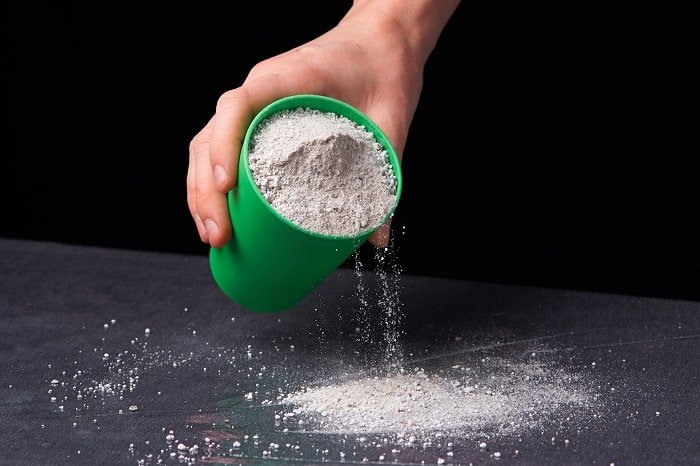If you have purchased potting
What is Perlite?
Perlite is a naturally occurring mineral that can be found in nature. It is mined in large quantities in Turkey, Japan, Greece, and in the United States. The mineral is formed as a result of the saturation of volcanic glass by water over a long period of time. Perlite contains a lot of ingredients which includes iron Oxide, Sodium Oxide, Calcium Oxide, Magnesium Oxide, Aluminium Oxide, Silicon Dioxide, and water.

Perlite has a lot of industrial applications such as construction and in the manufacture of ceiling tiles, plasters, and masonry. Before perlite can be added to soil for use in gardening or hydroponics, the mineral glass will have to be processed to form the tiny white balls appearance that it is known for.
To answer the question whether perlite is organic or not, I think it is safe to say that since it doesn’t contain carbon, perlite is an inorganic substance. But it is important to mention that as a naturally occurring mineral, perlite is completely non-toxic and safe to use for both hydroponic systems and in
What Are the Benefits of Perlite to the Plant Soil ?
Perlite is highly beneficial to garden and soilless systems and the secrets are in its distinct physical and chemical properties. The usefulness of perlite in the garden includes
- It has a neutral pH level which makes it able to balance the acid/base level of the
soil . - It is obtained from natural deposits in the
soil and hence does not contain any toxic chemical compound. - It is a physically stable mineral that has the ability to maintain its shape even under pressure in the ground.
- It is porous with tiny spaces which allows for easy aeration of roots for a stronger root system.
- It has the ability to retain the amount of water that is needed for plant growth while allowing the rest to run over; making it a great way to prevent drowning of plant roots due to erosion or over flooding.
FAQ’s
Should I add perlite to my garden?
I've seen a lot of people mention adding perlite to their gardens and wondered if it's something I should do. It seems like it would be a good idea because it would help retain moisture. I know it has been used as a soil amendment for years but I'm not sure if that is the best way to use it.
The perlite will slow the movement of water in the soil. It will also prevent some types of soil insects from burrowing. It's not a good idea to use it for the sole purpose of keeping pests away from your plants.
How does it work?
Perlite is a naturally occurring volcanic rock. Its porous structure allows water to pass through it and then evaporate, which helps plants grow faster. Perlite also provides an ideal growing medium for houseplants. It is used in gardening because it provides more air than other soils and thusly takes the soil less dense. In this manner it allows the plant roots to penetrate more easily.
It allows the plant roots to penetrate more easily. Makes the soil more friable and easier to work with. Lifts the soil surface, allowing water to reach the roots. Enhances drainage. It contains nutrients such as phosphorus and potassium, which are readily available to plants. Is not acidic or alkaline. Is not toxic. Is lightweight and therefore easy to move.
It is a lightweight, odorless, non-toxic, odorless, natural, dust-free, light-weight, non-shrinking, non-clumping, and non-expanding material.
How much perlite do I add to my garden?
Perlite can be purchased at nurseries and other stores that sell gardening supplies. It comes in bags or in bulk. You can also make your own by sifting the dry volcanic rock through a screen or fine mesh. Be careful not to crush the material as it will become too fine and will not work well as a mulch. When you first begin using perlite, you can start with small amounts and gradually increase the amount.
If you have a large garden, you can add as much as 1/4 cup perlite per square foot of garden. For smaller gardens, you can add less than this.
What are the disadvantages of perlite in gardens?
Perlite is a light weight material, which means it will be blown away by wind. When it is added to garden beds and containers, it can be a nuisance.
Perlite can be a problem in containers because it has a tendency to stick to plants and move around. If it is not removed from the container, it can cause problems such as clogged drainage holes. In addition to being a potential problem in containers, perlite can also be an issue in the landscape. When it is used as a soil additive or substrate in pots and containers, it can become dislodged from the potting mix and drift away from its intended location.
How Should You Use Perlite in the Garden?
Perlite has a wide range of applications in the garden, you can include perlite in your

You can also spread perlite on the

Josephine is an enthusiastic gardener who loves to spend her spare time tending to her garden. She is passionate about growing her own food, and aspires to one day have her own vegetable garden. Josephine is also an animal lover and often takes in stray cats and dogs. She enjoys spending time with her pets in the garden, and is often seen playing with them or watering her plants. Josephine is an avid reader and enjoys learning about new gardening techniques and plants. She is always looking for ways to improve her garden and make it more beautiful. She is a great friend, always willing to lend a helping hand when needed. Josephine‘s passion for gardening and love of animals make her a wonderful addition to any garden.




